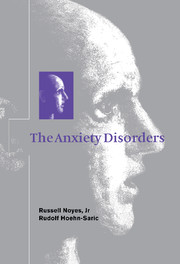Book contents
- Frontmatter
- Contents
- Preface
- 1 Normal anxiety and fear: psychological and biological aspects
- 2 Generalized anxiety disorder
- 3 Panic disorder and agoraphobia
- 4 Social phobia
- 5 Specific phobia
- 6 Posttraumatic stress disorder
- 7 Anxiety in the medically ill: disorders due to medical conditions and substances
- Index
5 - Specific phobia
Published online by Cambridge University Press: 22 March 2010
- Frontmatter
- Contents
- Preface
- 1 Normal anxiety and fear: psychological and biological aspects
- 2 Generalized anxiety disorder
- 3 Panic disorder and agoraphobia
- 4 Social phobia
- 5 Specific phobia
- 6 Posttraumatic stress disorder
- 7 Anxiety in the medically ill: disorders due to medical conditions and substances
- Index
Summary
Definition
Specific phobias, formerly called simple phobias, are characterized by fears of objects or situations known by affected persons to be harmless. Despite this knowledge, phobic individuals regularly react with intense fear when confronted with a phobic stimulus. According to Miller et al. (1974), fears become a phobias when they exceed the demands of the situation, cannot be explained or reasoned away, are beyond voluntary control, lead to avoidance of feared situations, persist over an extended period, are maladaptive, and are not age- or stage-specific.
The term phobia is derived from the Greek word ‘phobos’, meaning fear. Since Hippocrates, abnormal fears have been described but the term phobia was not introduced until the nineteenth century. Freud separated common phobias from realistic fears, while Kraepelin combined phobic and obsessive fears in his textbook in 1913. Phobias did not achieve a separate diagnostic category in ICD until 1947 or in DSM until 1952. In the 1960s, Marks (1987) subdivided phobic disorders; and DSM-III extended the division, while ICD maintained fewer distinctions (American Psychiatric Association, 1980). As Marks (1987) pointed out, phobias can develop in response to almost any object or situation. Indeed, some psychiatric textbooks from the turn of the century list more than a hundred Greek-named phobias. For taxonomic reasons, phobias were grouped in clusters. Decisions had to be made, when fears were common (e.g., of darkness, animals), about which ones were to be included in the classification. Similarly, phobias that occur as part of other psychiatric disorders were excluded.
- Type
- Chapter
- Information
- The Anxiety Disorders , pp. 205 - 235Publisher: Cambridge University PressPrint publication year: 1998



